The application functional size after an enhancement project does NOT include the size of the:
Which functional size (FS) is associated with the measurement at any time dring the application's lifecycle?
Which of the following is NOT an example of the purpose of a function point count?
Which of the following statements regarding functional size measurement is true?
Which term used in FP calculations reflects the size of the functions being changed by the enhancement project - as they are / will be after implementation?
Several functions are outlined within the following scenario for the Internet Application (IA):
- From the company intranet the user selects the IA application.
- The purchase item option allows the user to pay their internet shopping bill, after performing inquiry selection of items for purchase. The pay bill option updates the Customer, Inventory and Purchase History logical files.
- If this is the user's first purchase, the Customer Information screen captures information about the customer and stores it on the Customer logical file. Once the customer information is saved and the customer chooses the next option, they are returned to the Pay Bill option.
- If the user is an existing customer, they may view their customer information. The customer has the option of changing their information, but cannot delete it.
- An itemized report totaling monthly customer purchases is created at the end of each month.
From the Names of Possible Functions listed identify the transactional functions for the IA application. Select N/A if a Name of Possible Function does not apply.
Identify the functions used:
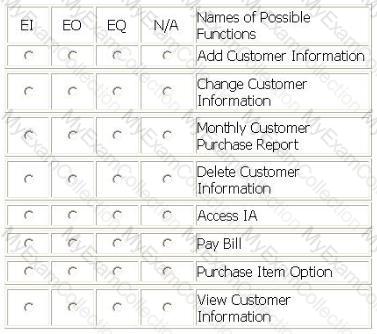
LIBRARY INFORMATION SYSTEM (LIS)
- The Lend Text functions allow the LIS user to register information about the texfs lending in the Lend logical file. Data stored and maintained in Lend are: ISBN code, enroll code, lend date, due date, return date.
- LIS maintains information about the Distributors from whom the library orders books, magazines and other publications. Account number, distributor name and 10 other logical pieces of information are maintained.
- Library Branch data is stored in LIS and is maintainable by the library staff. Information Is maintained on 10 branches. Data maintained includes branch id, branch name, location, directions, hours of operation, and 17 other logical pieces of information.
- Purchase Wish List logical file is maintained by LIS. Employees enter books, magazines, video recordings, audio recordings and personal computer software that they believe the library patrons would be interested in borrowing. This list is used as a source when making purchase decisions. The information is grouped by media type and information is collected based on the media type.
- There are 8 common pieces of data collected for all media types
- uk.co.certification.simulator.questionpool.PList@13512880
- Employee logical file is maintained in the LIS application and contains information about the library staff, including employee id, name, address, full or part time status, and title.
Determine the complexity of the following functions:
Select the complexity for each function
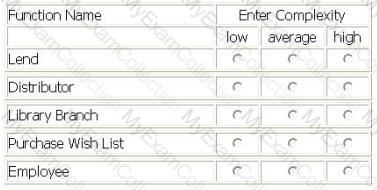
TAX APPLICATION
For the TAX application the user required the migration of existing taxpayer information (name, tax identification number, location name) to the TAX application. A conversion file with taxpayer data was created and imported into the Taxpayer logical file in the TAX application. The source of the data was the Account Holder logical file.
The user required the ability to Add, Change and Delete the taxpayer information in the Taxpayer logical file.
The user required the ability to View the taxpayer information prior to changing or deleting information.
From the Names of Possible Functions listed identify the base functional components for the TAX application baseline. Select N/A if a Name of Possible Functions does not apply.
Identify the functions used:
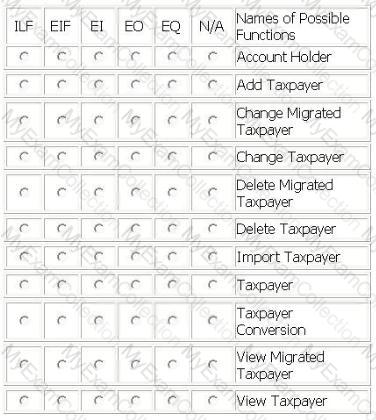
Identify the data and/or transactional functions in the following scenario:
In an international company, the user requires the Human Resources (HR) application to provide the following capabilities:
- All hourly employees must be paid In United States dollars
- When adding or changing employee information (name, social security number, number of dependents, type code, supervisory level, standard hourly rate, collective bargaining unit number, and location name), on the employee screen, the HR application must access the Currency application (CA) to retrieve a conversion rate. After retrieving the conversion rate, the HR application converts the employee's local standard hourly rate to a U.S. hourly rate using the following calculation:
- uk.co.certification.simulator.questionpool.PList@13512620
- When deleting employee information, on the employee screen, the HR application must NOT access the CA application to retrieve a conversion rate.
- The HR application must maintain employee information in the HR Employee logical file
- From the Names of Possible Functions listed identify the base functional components for the HR application. Select N/A if a Name of Possible Function Type does not apply.
Identify the functions used.
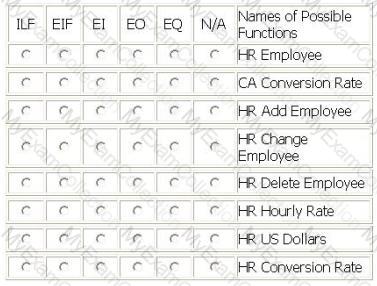
LIBRARY INFORMATION SYSTEM (LIS) - REPORTS
LIS produces five reports:
• Text Out On Loan
- References Customer logical file
- References Text logical file
- Displays 8 fields
• Text Overdue
- References Customer logical file
- References Text logical file
- Displays 4 fields
• Text With Multiple Hold Requests
- References Text logical file
- References Publisher Guide logical file
- References Customer logical file
- Displays 25 fields
• Inventory List
- References Inventory logical file
- Displays 12 fields including 1 calculated field
• Text On Order
- References Order logical file
- References Publisher Guide logical file
- References Text logical file
- References Employee logical file
- Displays 15 fields including 2 calculated fields
Determine the complexity of the following functions.
Select the complexity for each function:
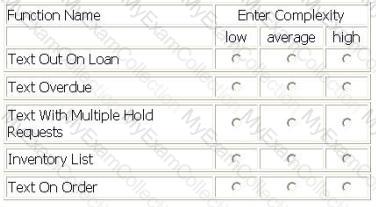
The Stock Purchasing (SP) and Point of Sale (POS) applications have the following requirements.
- The POS application maintains details of customer purchases in the Item Purchases logical file.
- The SP application is used to place orders with suppliers based on daily inventory levels.
- The SP application is used to maintain supplier information. The Supplier Information logical file contains descriptions of items the supplier stocks and supplier contact information.
- The Inventory logical file is maintained by the SP application through a daily batch process which references the Item Purchases logical file.
- When the batch process is complete, the SP application displays a list of items that are below 20% of normal inventory levels. The user selects items to be ordered and specifies the supplier. The SP application then generates a purchase order for each supplier. The purchase orders are sent electronically to each supplier and stored in the Order logical file.
- From the Names of Possible Functions listed identify the data function both the SP and POS applications. Select N/A if a Name of Possible Function does not apply.
Identify the functions used:
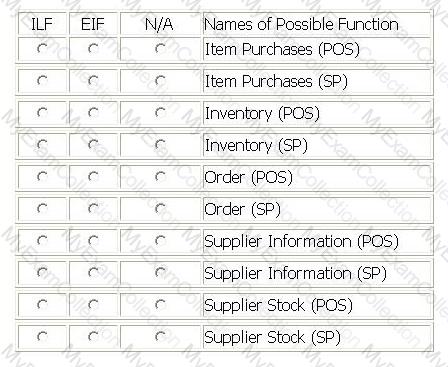
ITEM CHECK-OUT SCREEN
- Library employees use the Item Check-Out screen when a member is ready check out the book(s) and/or magazine(s) he wishes to borrow. The library employee enters the member id number, and when the employee exits the member id attribute, if the member id is valid, the member name is retrieved from the Member Information logical file and displayed in the member name attribute. The library employee enters the item type (b for book, m for magazine) and the item code; the item title is retrieved from the Book Information logical file and displayed in the item title attribute. The library employee then enters the lending date and the due date, and presses the Add button. The information is stored in the Check-Out logical file.
- Library employees use the Item Check-Out screen to update the due date of a book or magazine if a member requests additional lending time. The employee enters the member id number, and when the employee exits the member id attribute, if the member id is valid, the member name is retrieved from the Member Information logical file and displayed in the member name attribute, the library employee enters the item type (b for book, m for magazine) and the item code; the item title is retrieved from the Book Information logical file and displayed in the item title attribute and the lending date and due date are retrieved from the Check-Out logical file. The library employee then updates the due date, and presses the Update button. The new due date is stored in the Check-Out logical file.
- The head librarian receives two reports from the Library Check-Out application. The first report is the Overdue Report which is a list of overdue items categorized into < 30 days overdue, 30 - 90 days overdue and > 90 days overdue.
- The second report is the Low Usage Report that calculates which fiction books have not been checked out in the last 24 months and lists the title of those books. This report is run on demand. A High Usage Report with the number of times an item has been checked out has been put on hold and will not be released.
- A proposed Member Check-Out Report with a list of books checked-out and recommended titles will not be developed until privacy issues have been resolved.
- From the Names of Possible Functions listed identify the transactional functions for the current Library Check-Out application. Select N/A if a Name of Possible Function does not apply.
Identify the functions used:
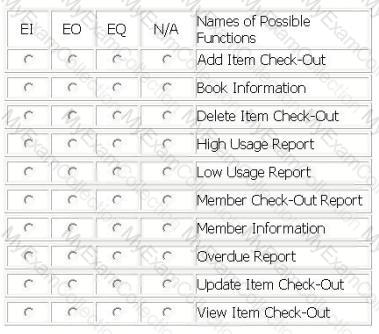
An enhancement project involves both the Human Resource (HR) application and the Mail Distribution (MD) application.
The HR application maintains all data elements in the Employee logical file. The users of the HR application require validations for employee pay grade and employee job title in the Employee logical file. The employee pay grade will be validated against the Pay Grade logical file which is maintained by the Finance application. The employee job title will be validated against the Job Title logical file which is maintained by the Compensation application.
The MD application maintains two data elements in the Employee logical file. The users of the MD application require additional validations for building and floor within the employee mailing address. The building and floor will be validated against the Building logical file which is a new file being developed by this project.
The users will use the MD application to maintain the Building logical file. The users of the MD application also maintain building and floor in the Employee logical file.
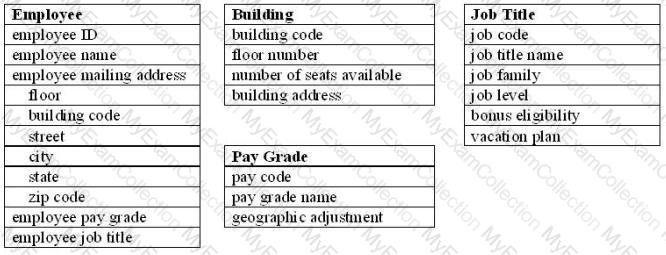
From the Names of Possible Functions listed identify the data functions for the HR application and the MD application. Select N/A if a Name of Possible Function does not apply.
Identify the data functions used:
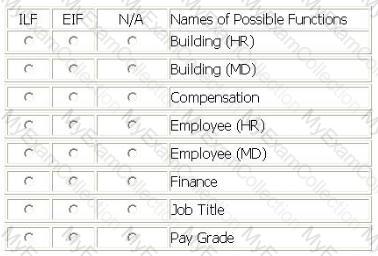
The Patient Billing application includes functionality to maintain the Patient logical file.
- The user enters a patient id and presses the View button to display an existing patient record, including diagnosis description and insurance company name. An error message is displayed if the patient record does not exist.
- The user Adds a new patient by entering a patient ID and the remaining values. The user completes the add by pressing the Add button. An error message is displayed if the patient id already exists.
- The user Updates information about the patient. All attributes can be modified except for patient id. The user completes the update by pressing the Update button
- A diagnosis code must be selected using a drop down list for the primary diagnosis and the secondary diagnosis. The drop down list function is identical for primary and secondary diagnosis. The Diagnosis logical file is maintained in the Patient Billing application and is the source for the Diagnosis Code Drop Down list. The Diagnosis Code Drop Down list displays the diagnosis code, description and authorized days of hospitalization.
- An insurance company code must be selected using the Insurance Company Drop Down list. The Insurance logical file is used as the source. The Insurance Company Drop Down list displays the insurance company number, group type and name.
- All other drop down lists use static data as the source.
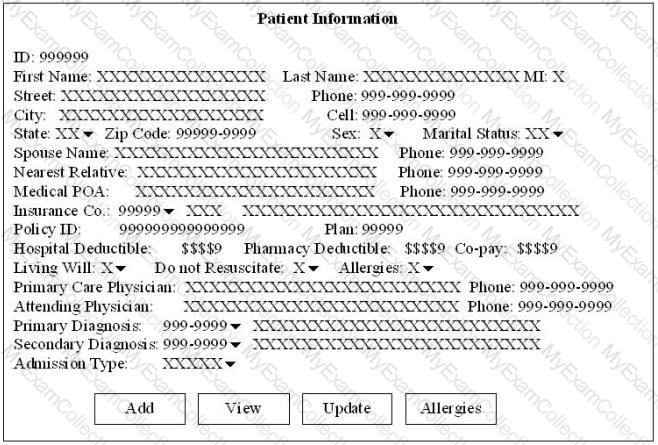
Determine the complexity for the following functions:
Select the complexity for each function:
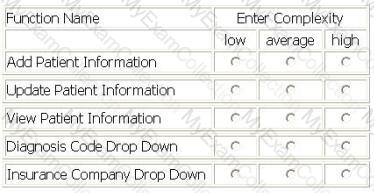
EXAM SCHEDULING SYSTEM (ESS) - EXAM SCHEDULING FUNCTIONS
- The controller uses the Maintain Exam Schedule screen to schedule exams for various courses and subjects.
- The exam serial number from the University Master logical file is entered in the screen. On pressing the Retrieve key, the exam name, controller number, finals week start date and finals week end date efe displayed from the University Master logical file. In addition, exam status, course id, subject id, exam date, start time, end time, proctor and message are displayed from Schedule Information logical file.
- The Add or Modify options allow addition/update to the course id, subject id, exam start date, start time, end time, proctor and message using the exam serial number as the key field. The data in the add/update mode gets saved in the Schedule Information logical file with the 'pending approval' in the exam status, no other data is stored.
- Course id, subject id and exam date pick lists provide data from static tables.
- The exam dates should be within the finals week start and end dates
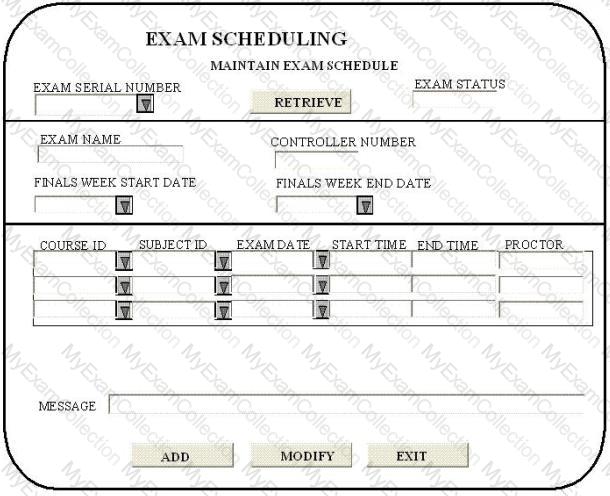
Determine the complexity for functions listed:
Select the complexity for each function:
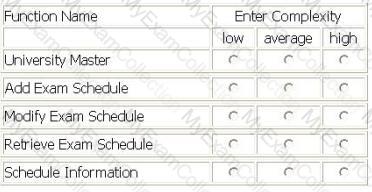
The Robot Automation Program (RAP) is an application which allows factory technicians to create and edit the weld placement programs for various robots on the assembly line. Both transactions maintain the Weld Specification and Robot logical files.
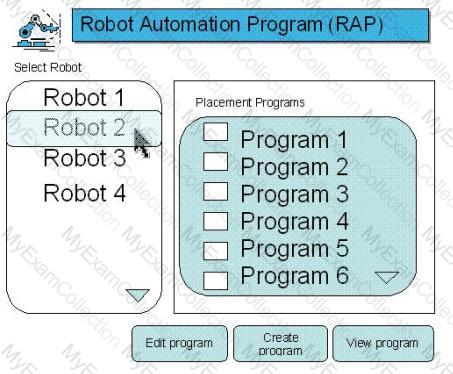
The use may select and view reboot details:
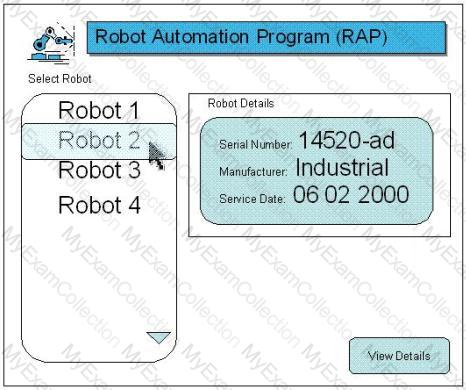
The user may print individual welding program details:
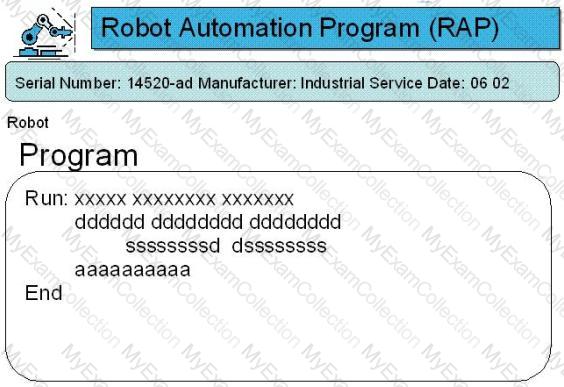
From the Names of Possible Functions listed identify the transactional functions for the RAP application. Select N/A if a Name of Possible Functions does not apply.
Identify the functions used:
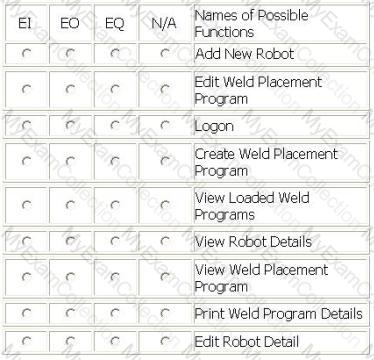
Software is developed to convert the data from the Account application to the Relationship Management application. The Account Master ILF and four other ILFs in the Account application are referenced to create the Client Master file in the Relationship Management application. How is (are) the conversion function(s) counted for the Application Function Point measure?
Conversion software is developed to convert data from the Account application to the new Relationship Management application. Five logical files in the Account application are referenced by the conversion software to create the new Client Master File in the Relationship Management application. How is the data conversion counted for the development project?
The revenue and expense amounts are retrieved from the General Ledger data store without any graph below be counted?
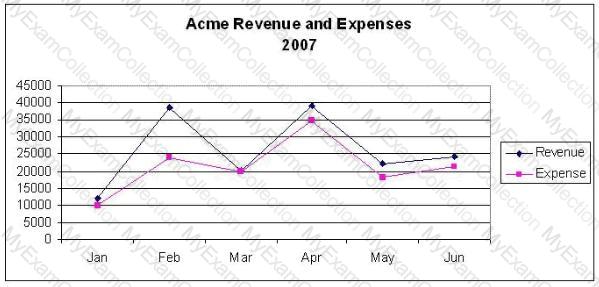
An application originally valued at 327 FP was enhanced. The enhancement added 3 low EQs, 2 low EIs and 2 high EOs. What is the AFPA?
The Account data store is maintained by 2 different applications, the Accounts Payable application and the Accounts Receivable application. Each application has its own unique view of the data. There are some common data elements, and some that are unique to each application. How would you count the Account data store?
The CCY application maintains the Currency Exchange file. The Currency Exchange file is copied into the Customer application on a daily basis to improve timely access to the data. The Customer application references the Currency Exchange file for all its transactions. How would the Currency Exchange file be counted in the Customer application?
The team has been asked to size the software associated with porting the Order Management system from one operating system to a different operating system. The project includes a one-time data conversion activity. Which of the following is true?
A report is created that displays all of the high net worth clients. The report calculates the net worth of a client by totaling the balances from all of their accounts with the firm including unrealized gains and losses. If the net worth of the client exceeds $5 million the client is included on the report. The report retrieves the name, address and phone number from the master account file and generates a list. How would this be counted?












